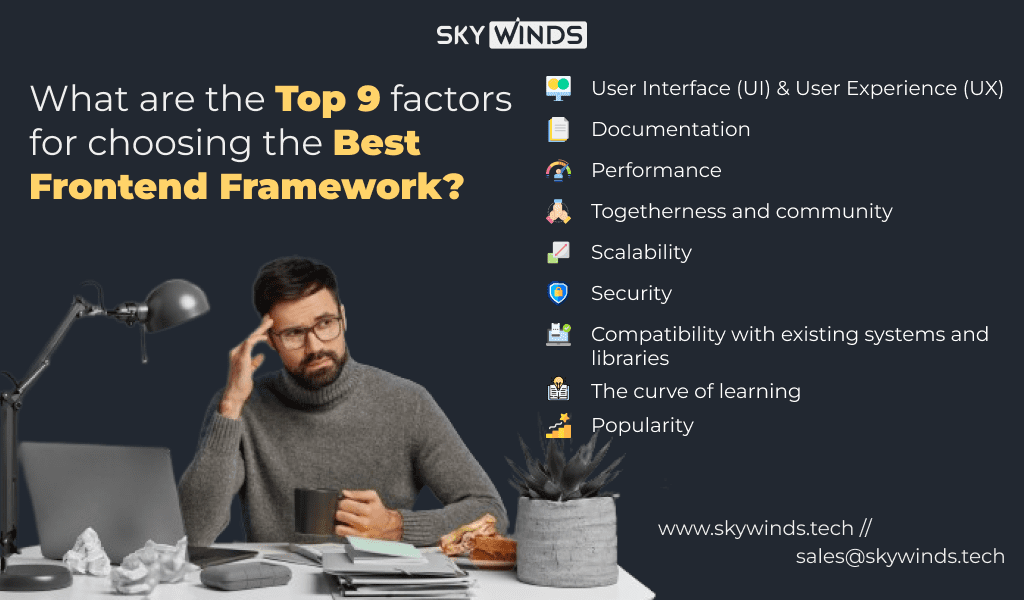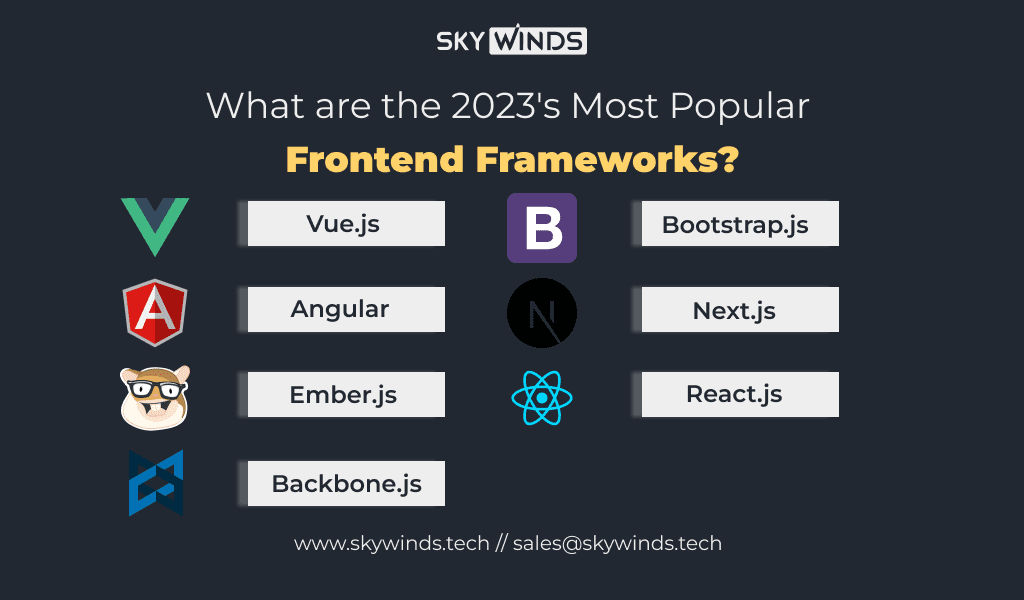Introduction
In the digital age we live in now, web apps have become an important part of our lives. Developers must carefully consider which frontend framework will best meet the ever-increasing need for feature-rich, user-friendly, and aesthetically pleasing online applications. Because of the abundance of alternatives, choosing the best Front-End Framework for Your Next Web App might be challenging.
With this blog, we bring you all the information you need to choose the best front-end framework for your next web application. So that you may choose the ideal framework for your project, we will examine their similarities and differences and their compatibility with other technologies.
What are the top 9 factors for choosing the best Frontend Framework?
Deciding on the best front-end framework for your web project might take much work. There are numerous choices to consider, and narrowing down the field might be difficult. To help you choose the finest front-end framework for your project, we’ll go through the top nine criteria to evaluate.

- User Interface (UI) & User Experience (UX)
A web app’s user interface and user experience (UI and UX) are two of its most important selling points. Whichever frontend framework you go with, ensure it has a clean, simple interface. The program should also be responsive, meaning it can change its layout to fit different screen sizes.
- Documentation
Assuring a streamlined development process relies heavily on thorough documentation. It’s a useful resource for programmers learning the framework’s capabilities. The framework should contain well-structured, thorough, and up-to-date documentation to save time looking for solutions to frequent queries.
- Performance
Your web app’s performance in terms of loading time and overall usability depends on the frontend framework you choose. The framework’s size, the rendering speed, and the number of resources used contribute to performance.
- Togetherness and Community
Finding the correct framework for your project depends heavily on the size and vitality of its community and support. A sizable user base guarantees that people can find guides, tutorials, and other information to help them fix issues, master new capabilities, and answer their queries.
- Scalability
The success of your web app depends on your ability to use a framework that can easily accommodate its expanding functionality. To prevent your app from failing or slowing down as traffic and data volume grow, ensure the frontend framework you choose is scalable.
- Security
While creating a website, security should always be a top priority. Selecting a frontend framework that offers security features like authentication, authorization, and encryption is important for keeping sensitive user information safe and thwarting hacking attempts.
- Compatibility with Existing systems and libraries
You may still require additional tools and libraries to help you complete your project, regardless of how feature-rich the framework you picked is. A framework that can adapt to changes is crucial for successful integration in such a situation.
DOM (Document Object Model) manipulation, temporal formatting, data processing, and rich-text editing are covered by different frameworks. Your framework has to be able to handle substantial integration procedures if you want to include all of this capability in your project.
- The Curve of Learning
Especially if you’re starting as a developer, the frontend framework’s learning curve is something you should seriously consider. Although some frameworks may be picked up and used quickly, others are more complex and take time to master. If you’re working under a tight schedule, it’s particularly important to consider how much time and effort you’ll need to learn and use the framework.
- Popularity
Whether or not a frontend framework is widely used is a major consideration when making a final decision. Every project with a long-term goal should use a widely-used framework to ensure they can always count on community support.
Suppose your web developers quit your project for any reason, and the framework is well-known. You can easily locate additional web developers for that specific framework technology, even for lengthier projects.
What are the 2023’s Most Popular Frontend Frameworks?
Here, we have compiled the most in-demand frontend frameworks for 2023, considering factors like brand recognition, business size, customer satisfaction, interest, usability, etc. This article will discuss the best six front-end JavaScript frameworks available in 2023.

In the six years following its introduction in 2014, Vue.js’s popularity has skyrocketed due to the framework’s capabilities. Vue.js is one of the many flexible front-end javascript frameworks that can be used to create beautiful online interfaces.
Vue.js is a frontend web development framework web designers use to create anything from tiny widgets to massive single-page applications. Vue.js’s adaptability makes it possible to include and coordinate with various libraries.
The advantages of using Vue.js are:
- This programming language is great for novice programmers since it is simple to pick up and use.
- It offers a quick and effective rendering method, leading to a highly functional website.
Drawbacks of Vue.js
- Compared to other frameworks, a smaller community uses this one, which means fewer resources and less support.
- Compared to other frameworks like React, the availability of plugins and libraries might be a limiting factor.
In 2016, Google released Angular, a framework built on typescript. Frontend and backend development are both manageable with AngularJS. Both a command line interface (CLI) and a graphical user interface (GUI) are included with this framework, making it accessible to newcomers. The package includes templates, full-stack tools, dependency injection, and integration best practices.
Benefits:
- Angular’s modular design allows it to run faster and deliver a more satisfying experience for end users.
- Because of its enormous user base, Angular has an abundance of documentation, guides, and tools that make it simple to pick up and start using.
Limitations of using Angular:
- The steep learning curve of Angular results from the framework’s complexity and breadth of ideas, making it less accessible to newcomers.
- Compared to other frameworks, Angular’s rigid structure and lack of flexibility might make it challenging to adapt to extraordinary situations.
Ember.js
Ember.js is a cutting-edge, component-based frontend framework. Ember has an effective architecture and is mobile and web-friendly. Ember.js may be a great option for developers who want to create highly productive, scalable apps for large-scale use cases, but there may be better matches for developers who are new to front-end development or working on smaller or simpler projects.
Benefits:
- Scaling and maintaining big systems is simplified by adopting a solid design and following established best practices.
- Features like automated code reloading, testing, and debugging tools contribute to a high degree of efficiency.
Drawbacks:
- Due to its sophisticated principles and convention-heavy approach, this framework has a steep learning curve.
- This framework may not be the best choice for smaller projects.
Backbone.js
Backbone.js, a lightweight framework developed in 2010, is based on the Model View Presenter (MVP) design. It provides a RESTful JSON interface and aids in constructing web apps that run locally on the client’s machine.
With an effective API that uses declarative event handling, structuring web applications using models is a breeze for use cases like key-value binding and for creating specialised events and collections. Therefore, Backbone.js is a good match for less complicated projects that don’t need many UI features, such as simple online apps with little data management requirements.
Advantages of Using Backbone.js:
- Easy to understand and manipulate
- The community is large and always willing to help
- The majority of issues may be resolved by consulting the documentation.
- Uses an elaborated prototype definition procedure as the basis for its inheritance model.
Disadvantages of Backbone.js:
- Maintaining several URI schemes or working with a non-RESTful API backend might be challenging.
- It might not be easy to do unit tests on backbone views. Including all test cases without code is difficult, which might cause issues.
- Several duplicate DIV elements are produced because an empty div element is used for each backbone view.
Bootstrap.js
Sites built using Bootstrap benefit from a mobile-friendly, flexible framework that is easy to update and maintain. Regarding frontend programming, this free and open-source toolkit is by far the most widely used option. Introduced that year, it gave programmers more leeway to adapt different parts to suit individual clients.
Advantages of Bootstrap.js:
- The grid is quick to react and highly reliable.
- Powerful JS plugins installed.
- The free and open-source SVG icons have been covered and conform flawlessly to the CSS-styled parts of their design.
Bootstrap.js’s Drawbacks:
- Bootstrap ensures visual consistency among its components. Although the sheets may be manually overridden or edited by anybody, learning to work within a grid system can take time and effort.
- Bootstrap’s generation of unnecessary, large files might bog down the system and drain the battery, necessitating manual elimination.
Next.js
Next.js is a free and open-source web application framework that enables React apps to use server-side rendering. The development of static websites is common. Now that automated status optimization is available; developers may create hybrid apps with server-side rendering and statically produced pages.
Next.js’s strengths:
- Excellent for search engine optimization (SEO), as it creates static websites that perform like dynamic ones
- decreases the product’s time to market
- The ability to adapt the interface and user experience
- Very strong backing from the community
Limitations of Next.js:
- No matter how little, every change to your program needs new code.
- Without an external state manager,
- Poor compatibility with plugins
- The cost-benefit analysis seems like it could be better.
React.js is a widely-used JavaScript toolkit for frontend development, specifically for creating user interfaces. React.js’s component-based design, virtual DOM, and high speed are just a few of its many strengths. Using React.js, designing and reusing UI components is simple, simplifying app upkeep and development. The virtual DOM speeds up page loads by delaying the time spent updating the sluggish DOM.
Advantages:
- A large and active community around React.js provides developers with a wealth of information and tools to help them create superior apps.
- In addition, React.js is well-known for its adaptability; it may be used with a wide range of resources.
Disadvantages
- There’s a significant learning curve, particularly for newcomers.
- The library’s syntax is difficult to learn and will improve your general knowledge of JavaScript and programming.
- Because of its exclusive emphasis on the user interface, developers using React.js must turn to other tools and frameworks for functionality like routing and state management.
Why Does Your Company Need the Finest Frontend Framework?
Future businesses in today’s era of digital-first impressions need to have a compelling identity. A website or portal that serves this purpose effectively is essential. If your company’s online presence is given priority, you can avoid losing customers. Your website is the primary visual representation of your brand.
In addition, frontend frameworks allow you to create a website with incredible interactivity. These are a few main reasons you should prioritize frontend development with the help of the most widely used frontend frameworks in 2023.
- First Impression
You can only succeed in attracting customers, who are your ultimate deity, by attracting them to your website. Just as the adage “the first impression is the last impression” is often used to assess human characters, so too can it be applied to the digital realm.
Your company’s website serves as its virtual storefront and first point of contact with potential customers. Web development is crucial to make a memorable impact on your audience.
- Boosts efficiency
Customers get aggravated with a sluggish website. The opposite is true when your site is visually beautiful, interesting to visitors, and quickly loaded.
- Identifies the Organization’s Goals
Users often get stuck in entertaining online interfaces and fail to see beyond a website’s visuals and other enticing aspects. The goal of your company may be realized via custom web development. Customers are more likely to stick with your website if they understand its objective from its design.
- Ability to Reuse Code
Web development using frontend frameworks is done for the express purpose of convenience and reusability. While working with a framework, it is possible to reuse the code for various website design components. Thus, investing in a useful framework can benefit your many web development tasks.
- Brand Identity
We are well aware of the significance of first impressions in web design and developing a brand’s identity. Building brand awareness that lasts in the minds of consumers is a primary goal of every web development project. A corporation may be recognized by its logo or website’s color alone, let alone by a simultaneous online display.
- Data Management
While building the front end of your website using a framework, the data model takes care of the application state, letting you connect to a reliable database with confidence.
- Confidence and Reliability
Your website represents the face and strength of your company. Customers will trust your business and its offerings through its website. Your company’s success may be greatly enhanced by investing in frontend development, which will make you a consumer favorite.
- Increases visitor engagement
Building your visitors’ trust and confidence in you takes time and effort, but a well-designed website may help. Only via your website can a potential client become a paying one.
You’ve probably encountered a few websites where the design is so annoying that you immediately close your browser tab and never return. What do you want prospective clients to see when they visit your company website?
- Enhanced Flowcharts
Have you, at any point, needed clarification while attempting to navigate a website? Well, of course, you have. Distracted and dispersed attention patterns make it easy to forget why you first visited a website.
Front-end development allows you to direct your site’s visitors along the most fruitful avenue for expanding your clientele. With a well-thought-out website structure, you can shape visitors into reliable clients.
Final Thoughts
To sum up, deciding on the right front-end framework for your next web project is a difficult and crucial challenge. Project needs, the skill of the development team, and community support are just a few of the elements that need to be carefully considered throughout the selection process.
The three most well-known frontend frameworks today are React, Angular, and Vue.js, each with its own advantages and disadvantages. Besides Angular and React, other frontend frameworks like Svelte, Ember.js, and Backbone.js have advantages and disadvantages, making them more suited to certain kinds of work.
Eventually, the needs of your next web app and your development team’s expertise will determine the ideal front-end framework to use.
If you are not sure about the choice of the frontend framework for your web development project, you can seek the professional help of our expert web developers and consultants. You can tell us your exact requirements and we will guide you in the decision to choose the right frontend framework. Being a top web development company, we have helped many startups and enterprises with the web development services right from planning to deployment. Book a free consultation call to discuss your queries and get the right answers.

